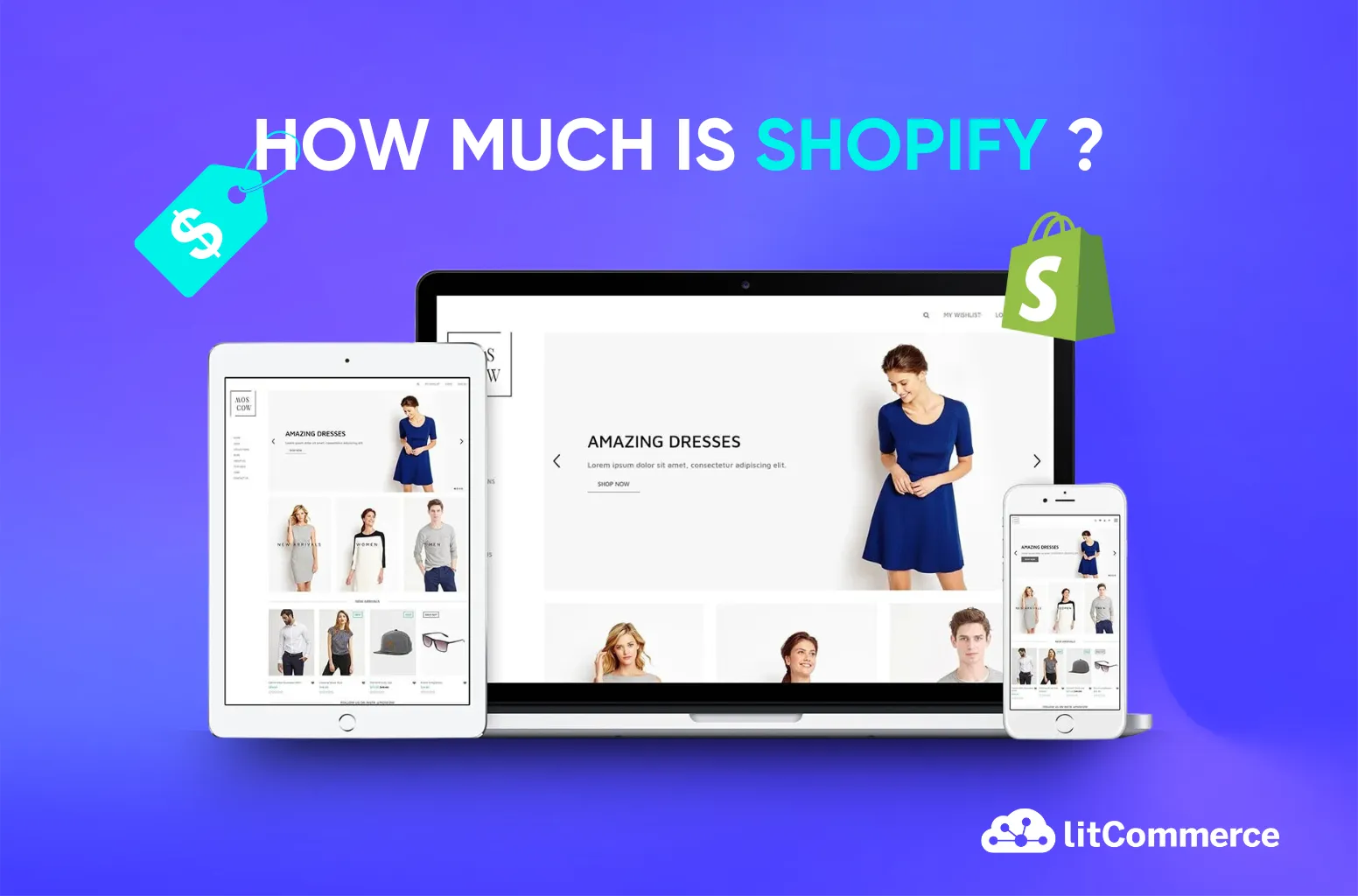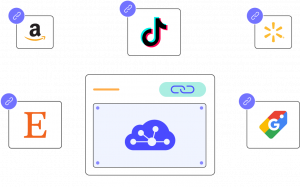If you’re planning to launch an online store, Shopify might be one of the top eCommerce platforms that come to mind. But before you dive in headfirst, it’s essential to know “How much is Shopify?”
With multiple Shopify plans available, it can be challenging to figure out which one is best suited for your business needs and budget.
To save you the trouble, in this article, we’ll explore:
- Overview of Shopify pricing plans
- Details on each plan’s features and benefits
- Other costs associated with using Shopify (transaction fees, credit card fees, etc.)
- Total Shopify cost per month (what percentage does Shopify deduct from revenue?)
- Tips to save money with Shopify plans
By the end, you’ll have a solid understanding of how much Shopify is and which plan is right for you. So, let’s get started!
Want to make $100,000 per month on Shopify?
With the right Shopify plan, you’re ready to start maximizing your revenue! Looking for a step-by-step guide to get started?
How Much Is Shopify? – An Overview
If you’re curious about “how much does Shopify cost?” the answer depends on your chosen pricing plan. Shopify provides 4 core plans and 3 alternative plans.
Each plan comes with a unique set of features and pricing structures that cater to different types and sizes of businesses.
Here is an overview of Shopify pricing plans:
How much is Shopify?
- Basic Shopify ($25/month) – Best for small businesses & new online stores
- Shopify ($65/month) – Best for growing businesses
- Advanced Shopify ($399/month) – Best for high-volume businesses
- Shopify Plus (from $2,300/month) – For enterprises & large brands
- Shopify starter ($5/month) – For social selling & beginners
- Retail ($89/month) – For brick-and-mortar stores using Shopify POS
- Enterprise (custom pricing) – For large organizations with unique needs
But before you commit to any plan, you can take advantage of Shopify’s 3-day free trial to test if it meets your needs. After that, you can access the $1/month in 3 months promotion.
So, how do you decide which Shopify plan best fits your business? Let’s take a closer look at each pricing plan they offer so you can make an informed decision.
How Much Is Shopify With Core Shopify Pricing Plans?
Here is a quick comparison between 4 Shopify pricing plans based on monthly price, yearly price, best use cases, and more to consider.
Shopify Plan | Basic | Shopify | Advanced | Plus |
Monthly pricing | $25 | $65 | $399 | Starting at $2,300 |
Billed yearly (save 25%) | $19/mo | $49/mo | $299/mo | Starting at $2,300 |
Target businesses | Small to medium-sized businesses | Growing businesses | High-volume businesses | More complex businesses |
Transaction fees | - 2.9% + 30¢ for online credit card transactions - 2.6% + 10¢ for in-person transactions - 2% fee for third-party payment providers | - 2.9% + 30¢ for online credit card transactions - 2.6% + 10¢ for in-person transactions - 2% for third-party payment providers | - Online: 2.4% + 30¢ - In-person: 2.4% - 3rd-party payment: 0.6% | Competitive rates for high-volume merchants |
Shipping discounts | Up to 67.6% | Up to 88.5% | Up to 88.5% | |
Staff member accounts | Doesn't support adding staff accounts | 5 | 15 | Unlimited |
Inventory locations | 10 | 10 | 10 | 200 |
Localized selling with custom markets | 3 markets included | 3 markets included | 3 included + $59/mo per added active market | 50 markets included |
Shopify POS Pro (per location) | $89/mo | $89/mo | $89/mo | 20 locations included or 200 with Shopify Payments |
1. Basic Shopify plan
Target business: Small businesses in the early stages of growth require more than just basic online selling capabilities.
How much is Shopify Starter: 25$/month | $19/month billed yearly (Save 25% off)
Third-party transaction fees: 2%
Credit Card Rates:
- Online transaction: 2.9% plus 30 cents
- In-person transaction: 2.7%
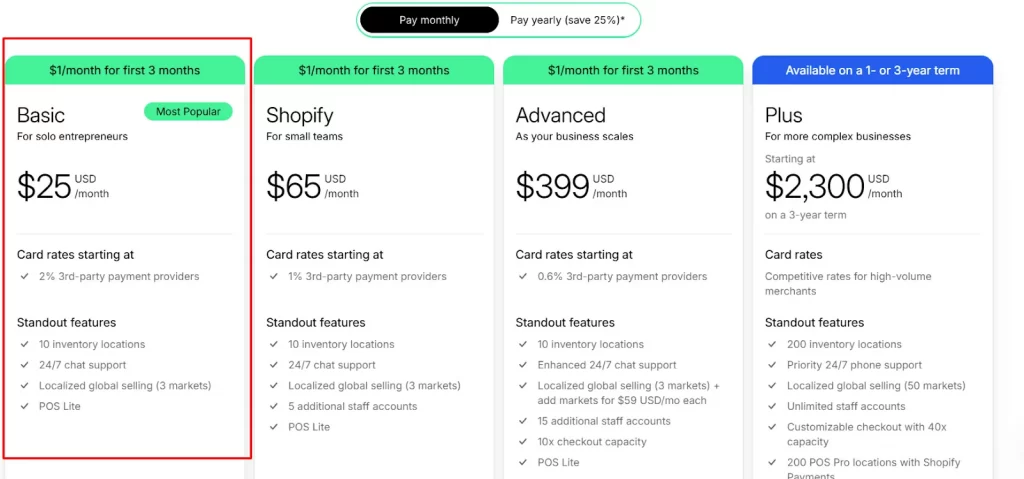
At just $25 per month, it’s the cheapest plan available and comes packed with features that small business owners will find helpful.
With Basic Shopify, you’ll also get handy features like:
- Branded eCommerce website that is customizable
- 24/7 customer support
- Manage up to 10 inventory locations
- Support for sales channels
- Unlimited product listings
- Abandoned cart recovery emails
- Discount codes
- Manual order creation
- Free SSL certificate to secure customer information
In light of the $6 per month discrepancy between monthly and yearly billing options, we advise opting for monthly billing initially to receive a $1 bill for the first three months. After 3 months, you should upgrade to the Shopify yearly plan to save $72 annually. You can do the same to other plans.
Is Shopify basic worth it?
Shopify Basic is a great starting point, but as your store grows, you may face some limitations such as higher transaction fees, lack of advanced automation, and limited customization. So, if you need scalability and cost-efficiency, you might want to consider Shopify’s higher-tier plans or alternative platforms.
Besides, you can use Shopify’s 3-day free trial and a $1/month for 3 months deal to help you test the platform risk-free.
2. Shopify plan
Target business: Medium-sized businesses require a more advanced set of eCommerce features compared to the Basic plan.
How much is Shopify plan: 65$/month | $49/month billed yearly (Save 25% off)
Third-party transaction fees: 1%
Credit Card Rates:
- Online transaction: 2.6% plus 30 cents
- In-person transaction: 2.5%
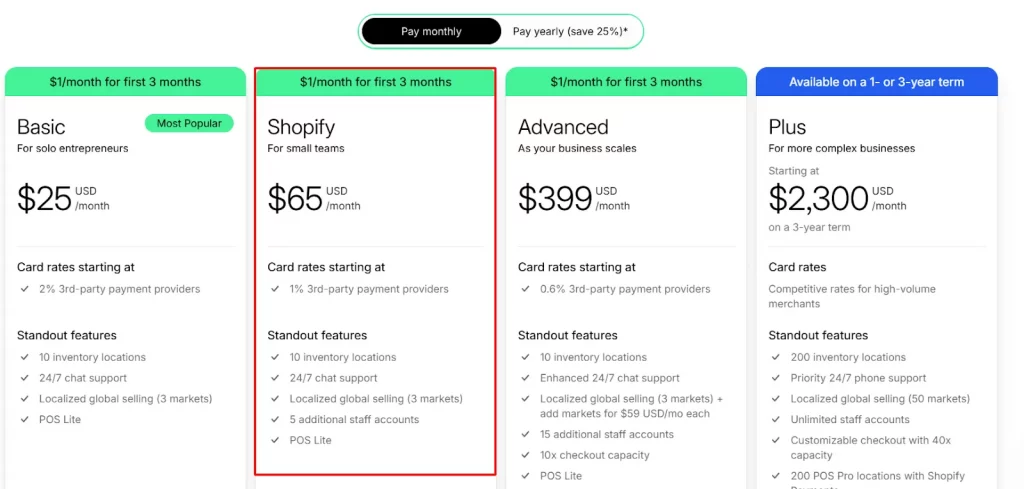
The Shopify plan is an excellent option at $65/month if you’re looking for a plan with more advanced features. It’s the most popular business plan, with almost everything Shopify offers.
With this Shopify pricing plan, you can easily track your sales performance and visitor behavior to make informed decisions for your store.
In addition to the features included in the Basic plan, this plan also offers additional features:
- 5 staff accounts
- Support for payment with gift cards
- Abandoned cart recovery feature
Besides, you can use automated emails to prompt these customers to meet their purchases and increase your sales.
My recommendation: Shopify plan is a great option for businesses on the rise. It offers lower transaction fees, additional staff accounts, and enhanced reporting capabilities compared to the Basic plan. However, as you scale your store, you’ll need to pay additional fees related to Shopify apps, POS features, etc.And for high-volume sellers who require advanced analytics or want to reduce fees even further, the Advanced plan at $399 per month could be more suitable.
3. Advanced Shopify plan
Target business: Growing businesses need advanced analytics tools to identify expansion opportunities and manage their operations effectively.
How much is Shopify Advanced plan: $399/month | $299/month billed yearly (Save 25% off)
Third-party transaction fees: 0.5%
Credit Card Rates:
- Online transaction: 2.4% plus 30 cents
- In-person transaction: 2.4%
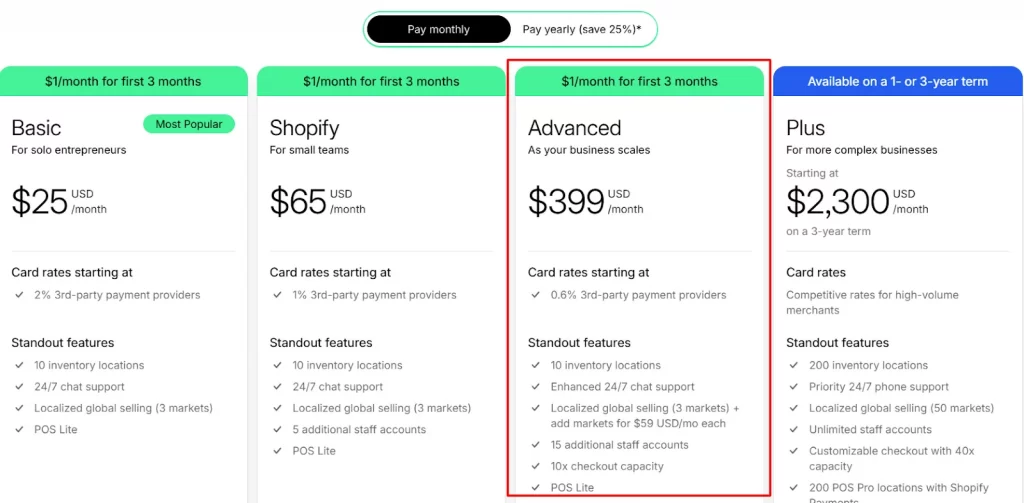
The Advanced Shopify plan is specifically designed for larger businesses with a bigger inventory and is available for $399/month.
With this fantastic plan, you’ll get access to all the features available on the Basic and Shopify plans, but with some additional perks.
Features included in advanced Shopify:
- Lower transaction fees
- Third-party calculated shipping rates
- 15 staff accounts
- Advanced reporting tools
- Custom report builder
- Unlimited storage, product listings, and media uploads
Overall, if your business makes over $10,000 in monthly revenue and you’re looking for better order fulfillment and store management, we recommend you choose the Advanced Shopify plan.
You might also want to read: How to Fulfill Orders on Shopify
4. Shopify plus
Target business: high-growth, enterprise-level businesses that need more customization, automation, and scalability.
How much is Shopify Plus plan: Start from 2,300$/month
Credit Card Rates: Competitive rates for high-volume merchants
Shopify Plus is a fully hosted platform so there are various additional fees beyond the monthly subscription fee such as:
- Data migration services: $1000 to $5000
- Custom website development: $50 to $3,000
- Maintenance costs: Variable based on ongoing needs

This Shopify Plus plan offers lots of powerful features and top-notch website hosting like:
- Unlimited staff accounts
- Support up to 40 times the standard checkout
- Manage up to 200 inventory locations
- Features specifically designed for wholesale and B2B transactions, catering to diverse business models
- Support for up to 200 POS Pro locations with Shopify Payments
- Customize Shopify Checkout with advanced branding and apps
- B2B on Shopify to sell wholesale and DTC from one admin and store
Therefore, you don’t have to worry about your site crashing when you get a surge of visitors. In fact, you can process up to 10,000 orders in 1 minute with this plan.
To qualify for Shopify Plus, your business should have an annual revenue of at least $1 million.
More Channels, More Revenue!
Did you know you can increase your revenue by selling on Shopify and other top marketplaces like Amazon, Etsy, eBay,…? With LitCommerce, managing everything is fast and hassle-free!
How Much Is Shopify with Alternative Shopify Plans?
In addition to its 4 main plans, Shopify offers flexible alternative options tailored to meet your specific needs.
1. Starter plan
Target businesses: New merchants prefer to use social media platforms or messaging apps to reach their customers instead of creating an online store.
How much is Shopify starter: 5$/month | 5$/month billed yearly
Third-party transaction fees: 5%
Credit Card Rates: The Starter Plan is designed for selling through social media channels or blogs. As a result, there is NO Shopify credit card fee.

If you’re just starting out selling online, you might want to consider the Shopify Starter plan. It’s only $5/month, and while it doesn’t come with an online store, you can easily add purchase links to your existing website. This makes it super convenient for your customers to checkout on both desktop and mobile devices.
Notably, the Shopify Starter plan has some basic features like managing online orders, inventory, and customer profiles. It’s perfect for small businesses just looking for minimal options and an easy setup to sell online. However, this plan is only available for new merchants and those in the free trial period.
2. Shopify retail
Target businesses: Businesses that operate physical retail stores and require a comprehensive point-of-sale (POS) solution to manage in-person sales effectively.
How much is Shopify Retail: $89/month
Third-party transaction fees: 2% for third-party payment providers.
Credit card rates:
- 2.9% + 30¢ USD for online transactions
- 2.6% + 10¢ USD for in-person transactions
Please note that the $89/month fee is just the starting cost.
For example, to use Shopify POS efficiently, you must purchase Shopify’s own hardware. Essential equipment like a card reader ($49-$299), barcode scanner ($229+), receipt printer ($149+), and cash drawer ($139+) can quickly add up, with total costs ranging from $500 to $1,000+ per store location.
What’s more, the $89/month POS Pro fee applies to each physical store location. So, if you run three retail stores, your total cost would be $267/month ($89 × 3)—before even factoring in hardware or transaction fees.

The Shopify Retail plan (POS pro) is designed for businesses that need robust tools for selling at retail locations.
At $89/month, it provides unlimited POS logins, allowing multiple staff members to access the system simultaneously. This plan also includes a limited online store, making it easier to manage both in-person and online sales from one platform.
Notable features of the Retail plan include:
- Secure, encrypted payments, unified inventory management across online and in-person sales, and access to a free Shopify POS app.
- Fast payouts, cash tracking, and the ability to issue gift cards.
3. Enterprise commerce
Target businesses: large-scale businesses and enterprises that require a robust, scalable platform to manage complex commerce operations across multiple channels, including B2C, B2B, and retail.
How much is Shopify Enterprise: Pricing is customized based on business needs and scale.
Third-party transaction fees: Variable, depending on the payment provider chosen.
Credit card rates: Competitive rates with potential for lower fees based on transaction volume and payment processing agreements.
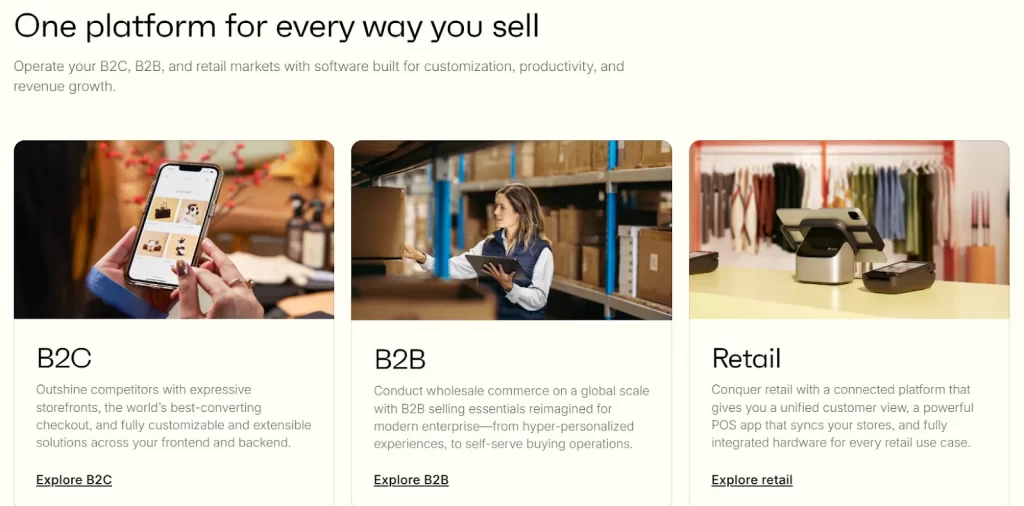
The Shopify eCommerce Enterprise plan offers a comprehensive solution for businesses looking to optimize their operations and drive significant growth.
With a focus on flexibility and performance, this plan offers many outstanding features to help enterprises innovate quickly and effectively manage high volumes of transactions:
- High performance with 99.9% uptime with less than 50ms response time
- Benefit from one of the highest conversion rates in the industry, with additional boosts when using Shop Pay
- Robust API access
To obtain pricing and explore available features, contact Shopify to schedule an exploratory call.
Shopify Pricing – Other Costs
If you’re considering setting up a Shopify website, you should be aware of other Shopify costs that may be involved. Below are a few things you may have to save your budget for!
1. Shopify website builder cost
Domain names
You don’t have to spend on installing or hosting your own domain because Shopify includes domain names in all its plans. You can choose any of the free myshopify.com domains or pay for a custom domain, which typically costs around $11 per year.
Depending on your domain type, the price can go up to $81. And if you already have a registered domain name, you can link it to your Shopify store for free.
Themes and design
Having a good design is crucial for your eCommerce website. Luckily, Shopify offers 11 free themes and over 110 premium themes that you can choose from. With these themes, you can customize your website’s colors, style, and layout. The premium themes cost between $180 and $350.
LitCommerce recommendations:
- For small businesses on a budget, Dawn (free on Shopify) is a simple, modern, and customizable theme.
- For medium-to-large businesses, Impulse ($350) boosts conversions, while Be Yours ($280) offers a clean, minimal look—ideal for fashion and beauty stores.
Both themes are well-rated, but as third-party options, ensure they fit your business needs before purchasing.
But what if you’re after a stunning Shopify theme that won’t cost you a dime? We’ve got you covered with our Top 6 Best Free Shopify Themes You Should Not Miss.
Apps
Shopify offers over 8000 apps that you can use to enhance the functionality of your store. Some apps cost money, while others are free. These apps allow you to include features that Shopify does not typically offer.
Here is a starter pack to function your new Shopify online store, our recommendations are based on our in-depth research and survey, so let’s take a look:
- LitCommerce: helps online sellers expand their business beyond Shopify. With seamless integration across top marketplaces like Amazon, eBay, and Etsy, centralized management, real-time inventory sync, bulk listing, and automation features, LitCommerce streamlines product listings, orders, and stock updates, ensuring a seamless selling experience across multiple platforms.
- PageFly: create customized landing pages and other types of content on the store without needing to know how to code. Its outstanding features include a drag-and-drop interface, pre-made SEO-friendly templates, and mobile responsiveness.
- Loox: collect and display customer reviews on their store in a professional and customizable way. Some of their impressive features, such as customizable review request emails, automated review collection, and social proof, etc.
- Dsers: help merchants sell products from AliExpress and want to streamline their order management and fulfillment process. What’s best? Dsers app has automated order fulfillment, multiple order processing, shipping & tracking management, and more to discover.
- Spocket: source high-quality and unique products for sellers who want to streamline their product sourcing and inventory management process. This app is suitable for dropshipping businesses.
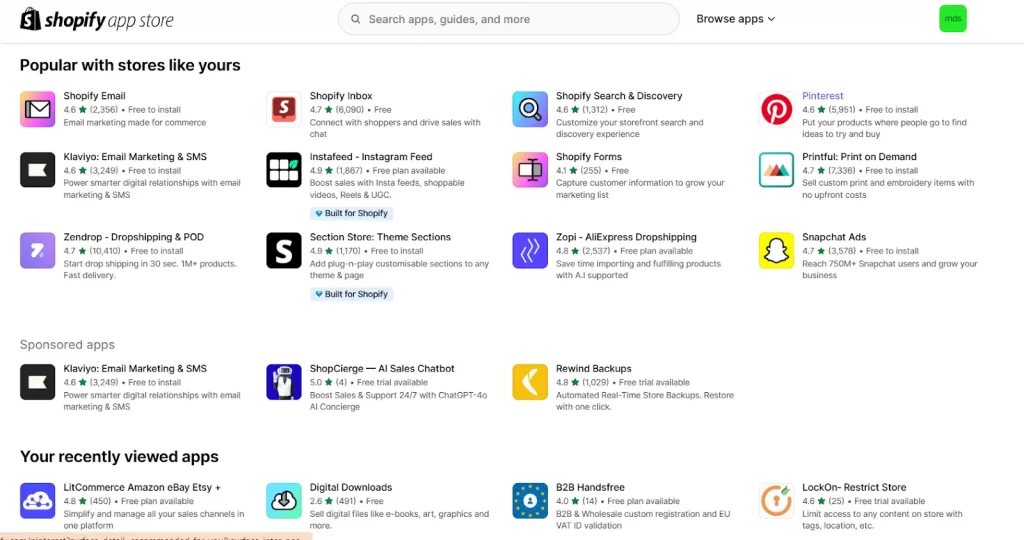
Tips for newbies: You can save money in the long run by adjusting Shopify monthly cost to annual.
You probably also want to read more details on the best Shopify review apps or Shopify free apps for initial setup.
2. Shopify transaction fees
Another thing to keep in mind when considering the Shopify costs of running your store are the transaction fees. These Shopify seller fees are charged whenever a customer purchases using a third-party payment service provider.
But don’t sweat up! The percentage of the fee you’ll be charged depends on the Shopify plan you choose.
For example:
- For the Basic Shopify plan, there’s a 2% fee on every transaction you make.
- If you upgrade to the Standard Shopify plan, the transaction fee is reduced to 1%, which can save you money in the long run.
- And in case, you’re really serious about growing your business and maximizing your profits, the Advanced Shopify plan has the lowest transaction fee at only 0.5%.
If you prefer to avoid these extra fees altogether, you can use Shopify Payments. It’s an option worth considering!
3. Shopify payments fees
This is really important because it can have an impact on your profit margin.
When you accept payments via credit card, Shopify charges you a fee.
Keep in mind that the Shopify processing fee is usually higher than other payment methods due to the risks associated with credit card payments.
Again, the good news is that the credit card rates vary depending on your Shopify plan.
For example:
- On the Basic Shopify plan, you’ll be charged 2.9% + $0.3 for online and 2.7% for offline credit card payments, respectively.
- On the Standard Shopify plan, it’s 2.6% + $0.30 for online and 2.5% for offline payments.
- Finally, the Advanced Shopify plan has rates of 2.4% + $0.30 for online and 2.4% for offline credit card payments.
Finally, you still have some additional Shopify selling fees, such as shipping label fees, Shopify Tax, and Shopify email, that you might want to check out all the details on this page.
Set Up Your Shopify Store with BulkFlow
Now that you know how much Shopify is, use BulkFlow to set up your store faster. It helps you import, edit, and export data like products, orders, and more, all in a few clicks.
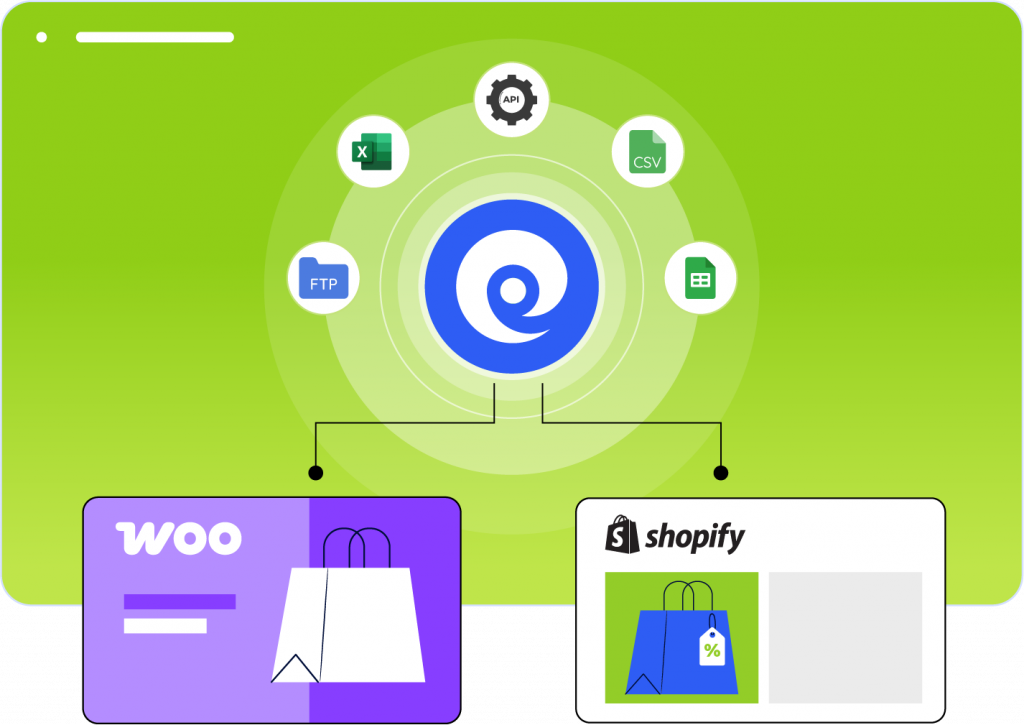
How Much Is Shopify Per Month?
So, as we’ve just gone through the breakdown of Shopify costs, here’s which fees you’ll need to take into account when asking “How much does Shopify take per sale”:
- Subscription fees
- Online payment fees
- Shopify apps
- Point of Sale (POS) fees
- Domain costs
And
- Shipping label fees
- Tap to pay on iPhone or Android
- Shopify tax transaction fees
- Shopify email
- Managing taxes
- Managing billing credits
Based on our experience with Shopify, we’ve estimated the Shopify monthly charges associated with using the platform in relation to your revenue:
If you choose the $65/month plan (or $49/month with an annual subscription) plus sales tax, you’ll incur a 2.4% transaction fee for credit card processing via Shopify Payments. Additionally, a $5/month app is required to enforce minimum order rules. Extra fees apply for third-party payment gateways.
In summary, Shopify’s estimated deduction from revenue is about ~3% – 5% (varies based on your sales volume, app usage, and transaction fees).
How to Optimize Shopify Plan to Save Money
Shopify costs can add up quickly if you don’t manage them wisely. Many businesses overspend without realizing it. Here, we’ll show you some common money-wasting mistakes and share strategic ways to reduce costs and boost profits on Shopify.
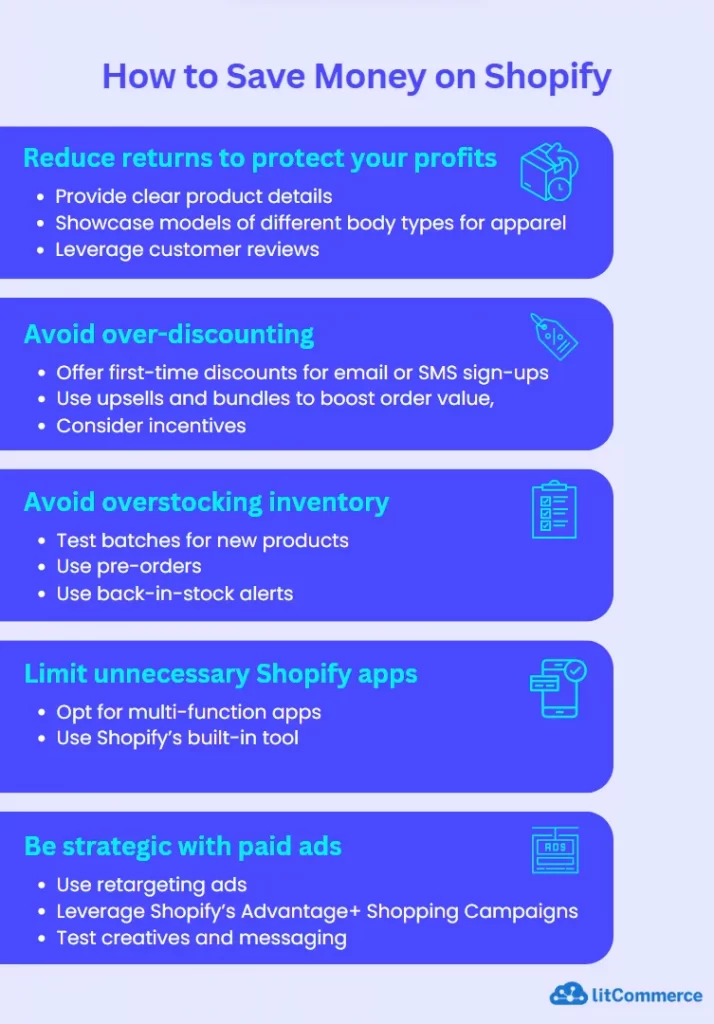
- Reduce returns to protect your profits: Returns are one of the hidden Shopify fees that new sellers often overlook. However, they can cut profits significantly through shipping, restocking, and customer service costs. Reduce them by providing clear product details, showcasing models of different body types for apparel, and leveraging customer reviews to highlight fit and quality.
- Avoid over-discounting: Discounts are great ways to attract customers. But frequent discounts will train customers to expect lower prices. Instead, offer first-time discounts for email or SMS sign-ups, use upsells and bundles to boost order value, and provide post-checkout offers on complementary products. Also, consider incentives like free shipping or gifts instead of direct discounts to maintain profitability.
- Avoid overstocking inventory: Buying too much inventory ties up cash and storage space. Base restocking decisions on sales data, start with small test batches for new products and use pre-orders and back-in-stock alerts to gauge demand before ordering large quantities. This prevents waste and improves cash flow.
- Limit unnecessary Shopify apps: Many store owners install too many apps, which can slow down the site and increase costs. Review apps quarterly, remove underperforming ones, and opt for multi-function apps like Automatic Discounts & Upsells. Use Shopify’s built-in tools for email marketing, discount codes, and abandoned cart recovery to minimize extra expenses.
- Be strategic with paid ads: When running paid ads, focus on one marketing channel at a time and use retargeting ads to bring back potential buyers. Also, leverage Shopify’s Advantage+ Shopping Campaigns for automated optimization. And don’t forget to regularly test creatives and messaging to find the best-performing ads before scaling your budget.
Expand Your Reach with LitCommerce Product Feed
Effortlessly advertise your Shopify store across 300+ platforms with LitCommerce product feed. Save time and maximize exposure with just a few simple setup steps.
Shopify Pricing Plan – FAQs
- How much is Shopify a month?
There are 4 main Shopify pricing plans to choose from
- Starter plan: $5 per month
- Basic Shopify plan: $39 per month
- Shopify plan: $105 per month
- Advanced Shopify plan: $399 per month
However, you can save 25% when registering the annual plan ranging from $29 to $299.
- What fees does Shopify charge?
If you’re using Shopify Payments, it will charge you $0 transaction fees.
However, if you use a third-party payment provider instead, you’ll be charged an additional fee.
- For Basic Shopify plan, this fee is 2%.
- For Shopify plan, it’s 1%.
- And for Advanced Shopify plan, it’s just 0.5%.
Conclusion
Based on a deep dive into the question “How much is Shopify” we can conclude that Shopify offers a variety of pricing plans to fit different needs and budgets.
However, to start selling on Shopify, you must also acknowledge other costs beyond just the Shopify subscription fees to avoid unexpected expenses that can exceed your budget.
So, if you have any questions or need assistance, don’t hesitate to contact us. And if you’re looking for more eCommerce tips and advice, be sure to visit our Retail Blog or our Facebook community. Thank you for reading!

